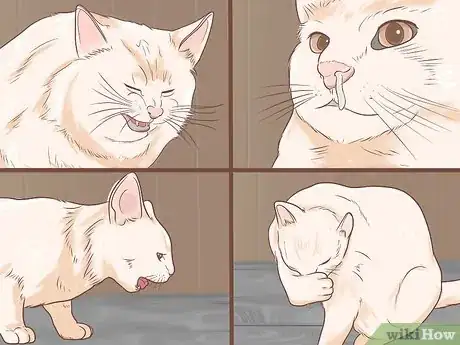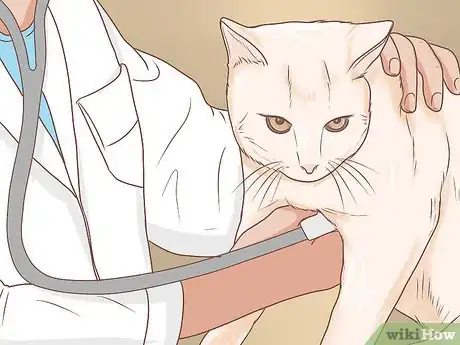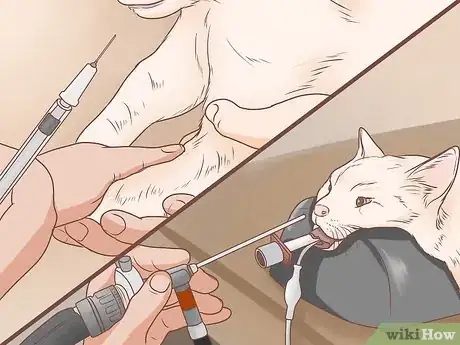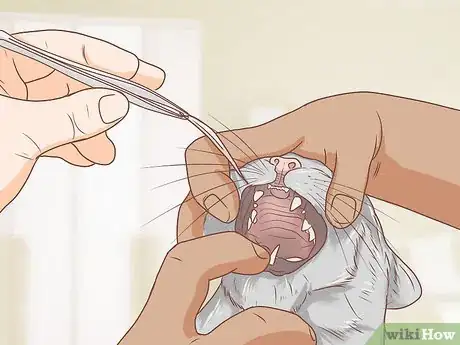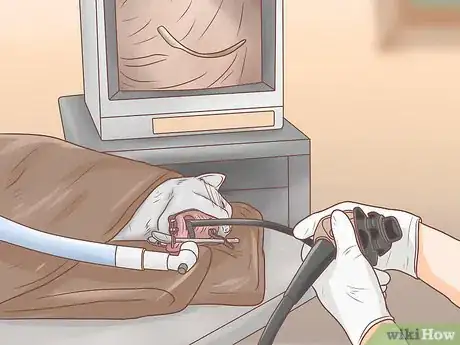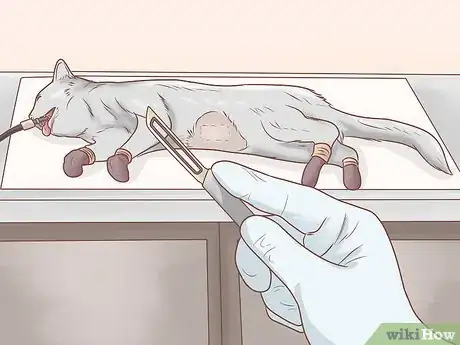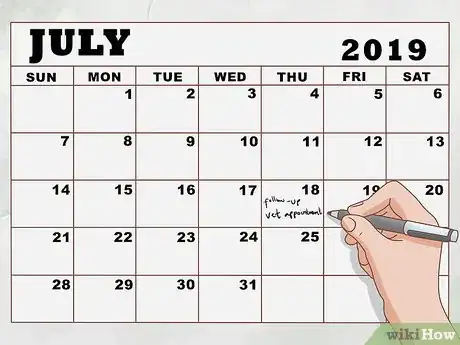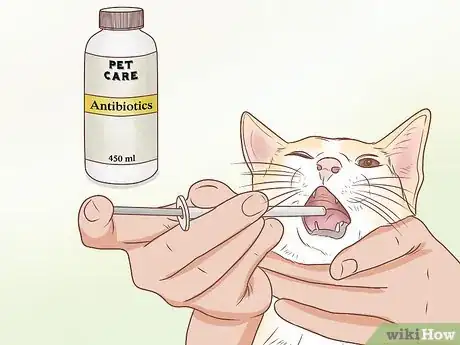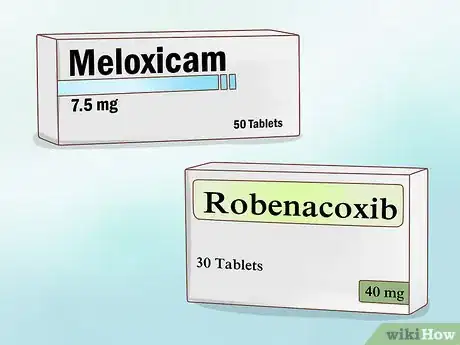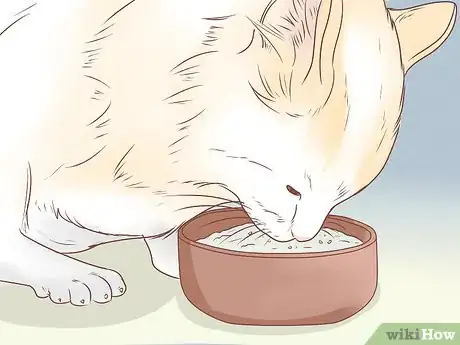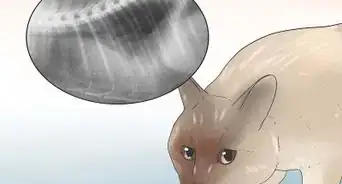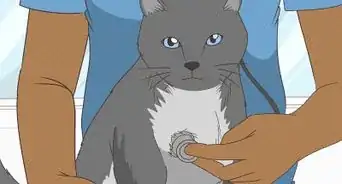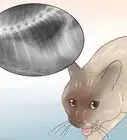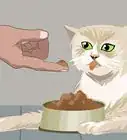This article was co-authored by Deanne Pawlisch, CVT, MA. Deanne Pawlisch is a Certified Veterinary Technician, who does corporate training for veterinary practices and has taught at the NAVTA-approved Veterinary Assistant Program at the Harper College in Illinois and in 2011 was elected to the board of the Veterinary Emergency and Critical Care Foundation. Deanne has been a Board Member of the Veterinary Emergency and Critical Care Foundation in San Antonio, Texas since 2011. She holds a BS in Anthropology from Loyola University and an MA in Anthropology from Northern Illinois University.
This article has been viewed 83,790 times.
Foreign bodies, such as a blade of grass, can become lodged in your cat’s respiratory system. This can cause your cat severe discomfort and pain and, if left untreated, it may result in the development of a chronic lung disease or even death. In order to clear respiratory foreign objects from your cat, you should watch for common symptoms, take your cat to the vet for a thorough diagnosis, and then have your vet retrieve the object. In most cases, the object may be stuck in the nose or throat, where it can be removed quickly and safely. If the object is deeper within the respiratory system, however, the cat may need surgery. In both situations, you will need to schedule follow-up appointments with your vet to assist with recovery.
Steps
Diagnosing a Respiratory Foreign Body
-
1Notice common symptoms. Foreign bodies can get lodged in the nose, throat, trachea, or bronchi of a cat, and the symptoms vary depending on the exact location of the foreign object. Look for any of the following symptoms:[1]
- Nasal discharge
- Sneezing
- Nose-pawing or nose-bleeds
- Head shaking
- Gagging
- Salivation
- Difficulty swallowing or breathing
- Bad breath
- Pawing at the face and mouth
- Coughing
- Retching
- Blue coloured gums
- Fainting
- Anorexia
-
2Monitor your cat while outside. In most instances a foreign body, such as a blade of grass or a piece of a stick, will enter your cat while they are smelling or chewing these objects. Keep a close eye on your cat while it is playing outside. This way you will have a better indication of what might be the problem if your cat starts to develop symptoms.[2]Advertisement
-
3Take your cat to the vet. If you notice any common symptoms associated with a respiratory foreign body, or you believe your cat may have inhaled a foreign object, you should take your cat to the vet immediately. If left untreated, a foreign body in the respiratory system could cause an infection or lead to chronic lung disease. In some cases the foreign object may travel through the body, causing severe complications and even death.[3]
- Your vet will need to run a number of tests in order to rule out other possible illnesses and to find the exact location of the foreign object.
-
4Have your cat examined. Your vet will likely need to administer a number of examinations in order to determine the exact location of the foreign object. An examination can also provide your vet with more detailed information concerning the type of object that has been lodged in the respiratory system. Your vet may administer any of the following tests:[4]
- A complete blood count (CBC), biochemical profile, and urinalysis.
- An x-ray of the throat and chest.
- Skull/nasal radiographs.
- A scope may be used to evaluate the nasal cavity, trachea, and bronchi.
- A CT Scan or MRI may be useful in some cases.
Removing a Foreign Body
-
1Remove the object manually. This is often done by administering a local anesthetic and then reaching in and grabbing the object from the throat or nasal cavity. This type of removal is only possible if the object is visible and easily accessible.[5]
- In some cases, you may be able to do this without the help of a vet, if you are able to see the object and are certain you can remove it completely and without causing any damage to the nasal passage. It is safest to let the vet do any removal, however.
-
2Flush the respiratory tract to remove the object. Your vet may be able to encourage the foreign object to dislodge itself, by flushing the respiratory tract. A sterile saline solution will be flushed through the respiratory tract in the hope of dislodging and washing out the foreign object.[6]
-
3Retrieve a foreign body using an endoscope. To remove a foreign body using an endoscope, the vet will place a flexible tube called an endoscope into the cat’s mouth and down into their throat. They may try to pull out the object. Typically the object will be removed using forceps or a balloon catheter.[7]
- This procedure will typically only work if the object is lodged in the throat.
- If the lodged object is sharp, a protective tube can be placed down the cat’s throat to protect the esophagus while the object is retrieved.
-
4Remove a foreign body through surgery. In severe cases, the foreign object may be lodged deep within your cat’s internal respiratory system. In these instances, the vet may need to complete a surgery to remove the object. In most cases, your cat will be put under general anesthesia.[8]
- There are always risks when your cat undergoes surgery, especially when the cat is under anesthesia. Talk to your vet to understand the risks and benefits of surgery for your cat.
Aiding the Cat's Recovery
-
1Schedule a follow-up appointment with your vet. Although cats can recover quickly from removal procedures, it is still a good idea to schedule a follow-up appointment with your vet. During this appointment your vet will check to make sure that your cat is not suffering from any lingering pain or infection as a result of the lodged object or removal procedure.[9]
-
2Treat secondary infections with antibiotics. Your vet may notice that the foreign body has caused a secondary infection. This happens if the foreign body contained bacteria that was spread to the cat. If this is the case, your vet will prescribe antibiotics to help treat the secondary infection.[10]
- Follow all instructions provided by your vet for administering the antibiotic.
-
3Provide your cat with pain medication. Following the surgery, your vet will most likely prescribe pain medication, as both the surgery and the recovery can be painful for the cat. It is very important that you follow of the instructions provided by the vet when administering medication.[11]
- For example, your vet may prescribe a nonsteroidal anti-inflammatory drug (NSAID), such as meloxicam or robenacoxib.[12]
-
4Feed your cat a softer diet. Giving your cat wet food can also alleviate pain following this procedure. This type of food is typically softer and will be less irritating if your cat experienced a foreign body lodged in the respiratory system. Talk with your vet to see if this is a suitable option for your cat.[13]
Warnings
- Foreign bodies are more frequently inhaled by outdoor cats. This is because they are breathing in grasses, plants, and dust.[15]⧼thumbs_response⧽
- The removal of foreign objects from your cat’s respiratory tract can be quite costly. Depending on the exact procedure, this can range in cost from $500 to $2,000 USD.[16]⧼thumbs_response⧽
References
- ↑ https://www.vetary.com/cat/condition/foreign-objects-stuck-in-throat
- ↑ http://www.petplace.com/article/cats/diseases-conditions-of-cats/lungs-airways-chest/foreign-body-in-cats-respiratory
- ↑ http://www.petplace.com/article/cats/diseases-conditions-of-cats/lungs-airways-chest/foreign-body-in-cats-respiratory
- ↑ http://www.petplace.com/article/cats/diseases-conditions-of-cats/lungs-airways-chest/foreign-body-in-cats-respiratory
- ↑ http://www.theveterinaryexpert.com/feline-medical-problems/nasal-discharge-and-sneezing-in-cats/
- ↑ https://www.vetary.com/cat/condition/foreign-objects-stuck-in-throat
- ↑ https://www.vetary.com/cat/condition/foreign-objects-stuck-in-throat
- ↑ http://www.pethealthnetwork.com/cat-health/cat-diet-nutrition/did-your-cat-eat-something-weird
- ↑ https://www.vetary.com/cat/condition/foreign-objects-stuck-in-throat
- ↑ http://www.petplace.com/article/cats/diseases-conditions-of-cats/lungs-airways-chest/foreign-body-in-cats-respiratory
- ↑ https://www.vetary.com/cat/condition/foreign-objects-stuck-in-throat
- ↑ http://journals.sagepub.com/doi/pdf/10.1016/j.jfms.2010.05.004
- ↑ https://www.vetary.com/cat/condition/foreign-objects-stuck-in-throat
- ↑ http://www.petplace.com/article/cats/diseases-conditions-of-cats/lungs-airways-chest/foreign-body-in-cats-respiratory
- ↑ http://www.vetfolio.com/diagnostics/feline-focus-update-on-feline-upper-respiratory-diseases-introduction-and-diagnostics
- ↑ https://www.vetary.com/cat/condition/foreign-objects-stuck-in-throat
About This Article
To clear respiratory foreign bodies from a cat, start by taking it to the vet as soon as you notice symptoms, such as gagging, difficulty breathing, or head shaking. If the object is in the throat or nasal cavity, your vet may try to remove it manually after giving your cat an anesthetic. Alternatively, they may perform surgery to remove the object if it’s lodged deep in the respiratory system. Once your cat is back home, make sure to give it any prescribed medications and feed it soft food, which is easier for it to swallow. For more advice from our Veterinary co-author, including how to keep your cat from swallowing things, read on!
